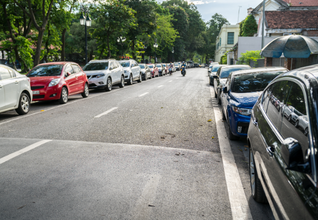Parallel parking can be a challenging driving manoeuvre for many people, but it’s an essential skill to learn for anyone who wants to drive in urban areas. With some practice and patience, anyone can become proficient at parallel parking. In this blog, we’ll walk you through how to parallel park so you can do it confidently.
Step 1: Finding a Suitable Parking Spot
The quest for the perfect parking space is the first step in parallel parking. Aim for a spot that’s at least a few feet longer than your vehicle, free of hazards, and legal.
Remember, blocking driveways is not just discourteous—it’s illegal. Once you’ve found your spot, signal your intentions to other drivers by using your indicator.

Step 2: Maneuvering into Position
Once you’ve signalled your intent to parallel park, it’s time to manoeuvre your car into position. Start by pulling up parallel to the car in front of the space.
After signalling, align your car parallel to the vehicle in front of the parking space, maintaining a two to three feet distance. Shift into reverse and back up slowly, turning your steering wheel towards the curb side. Continue until your rear wheel is aligned with the other car’s bumper.

As you’re backing up, turn the steering wheel to the right (or left, depending on which side of the road you’re parking on). Keep reversing until your back wheel is even with the other car’s back bumper.
Step 3: Straightening Out
Once your back wheel is even with the other car’s back bumper, it’s time to straighten out. Begin by turning the steering wheel in the opposite direction from before (i.e., left if you turned right earlier).
Continue backing up slowly until your car is parallel to the curb. You may need to adjust your position slightly as you go, so be prepared to make minor corrections.
Step 4: Adjusting Your Position
If you’re not entirely parallel with the curb, you can adjust your position by shifting your car into drive and pulling forward slightly. Then, shift back into reverse and repeat the steps to straighten out.
Step 5: Plenty of Practice
Parallel parking can be tricky at first, but the more you practice, the easier it will become. Find an empty parking lot or a quiet street where you can practice your parallel parking skills without worrying about other drivers. Take your time and be patient – it may take a while to get the hang of it, but with practice, you’ll soon be able to parallel park confidently.
When Would You Need to Parallel Park?
Here are some common scenarios where you may need to parallel park:
- Street Parking: In urban areas, parallel parking is often the only option for parking on the street. Parallel parking may be your only choice if you need to park on a busy city street.
- Tight Spaces: When parking in a crowded car park or garage, you may need to parallel park in a tight space to fit your car in. It can be beneficial if you need to park quickly.
- Residential Areas: If you’re visiting a friend or family member in a residential area, you may need to parallel park on the street. Knowing how to parallel park can make the process easier and less stressful.
If you can’t parallel park or practice it, you may be put off parallel parking, which reduces the number of parking options you have.
Conclusion
Parallel parking may seem daunting initially, but anyone can learn how to do it with practice and patience. Remember to take your time, check your surroundings, and be prepared to make minor adjustments as you go. With these tips in mind, you’ll soon be able to parallel park like a pro. Good luck!
Mastered parallel parking and ready to take on the roads? Ensure you’re covered with a personalised car insurance quote from KennCo Insurance. Get an instant Online Insurance Quote or contact one of our agents today at 0818 25 20 25.

